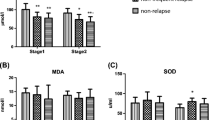Abstract
The aim of this work was to study the dynamics of oxidative stress in the blood and urine of children with kidney diseases: glomerulonephritis (GN), pyelonephritis (PN), renal failure (RF), and lower urinary tract infections (LUTI). The concentration of conjugated dienes is increased in blood: GN 4 times and RF up to 2 times; and extremely increased in urine: GN 12 times and RF 4 times. The concentration of thiobarbituric acid reactive substances in urine shows a similar trend: GN 7 times, PN 2 times, RF 1.5 times, and LUTI almost 3 times. Urine chemiluminescence is also increased: GN 5 times, PN and LUTI 3 times, and RF 6 times. Kidney disease leads to 2.5-fold inhibition of antioxidant catalase activity in blood and 10-fold in urine. Total antioxidant activity of urine is induced in all groups: GN 18 times, PN 2 times, RF 1.5 times, and almost 4 times in the LUTI group. Experimental data confirm that products of lipid peroxidation, intensity of chemiluminescence, and total and enzyme antioxidant capacity in combination with clinical parameters are a proper test for the dynamics of oxidative stress and markers of intoxication in children with inflammatory and immunological active parenchymal kidney disorders. These data could be helpful for the optimization of complex and effective antioxidant therapy of children with kidney disease.





Similar content being viewed by others
References
Halliwell B, Gutteridge JM, Cross CE (1992) Free radicals, antioxidants, and human disease: where are we now? J Lab Clin Med 119(6):598–620
Modlinger PS, Wilcox CS, Aslam S (2004) Nitric oxide, oxidative stress, and progression of chronic renal failure. Semin Nephrol 24(4):354–65
Halliwell B (1994) Free radicals, antioxidants, and human disease: curiosity, cause, or consequence? Lancet 344(8924):721–4
Armstrong D, Browne R (1994) The analysis of free radicals, lipid peroxides, antioxidant enzymes and compounds related to oxidative stress as applied to the clinical chemistry laboratory. In: Armstrong D (eds) Free radicals in diagnostic medicine. Plenum, New York, pp 43–58
Nath KA, Salahundeen AK, Clark EC, Hostetter MK, Hostetter TH (1992) The role of cellular metabolites in progressive renal injury. Kidney Int S42:109–113
Locatelli F, Canaud B, Eckardt KU, Stenvinkel P, Wanner C, Zoccali C (2003) Oxidative stress in end-stage renal disease: an emerging threat to patient outcome. Nephrol Dial Transplant 18(7):1272–80
Vladimirov JA, Azizova OA, Deev AI, Kozlov AV, Ossipov AN, Roshtupkin DI (1991) Free radicals in living systems. In: Science and technique reviews, Biophysics series, Moscow, VINITI, 29:1–252
Chernjak NB (1976) eds. Erythropoiesis and its regulation. Moskow, Мoskow, pp 59–162
Grinstein IuI, Andrianova GP (1988) Status of the antioxidant system and free radical lipid peroxidation in patients with chronic renal failure. Ter Ark. 60(6):54–6
Pringle MJ, Chapman D (1980) The dynamics of biomembranes and implications for membrane disease. Biochem Soc Trans 8(6):686–8
Shan SV (1989) Role of reactive oxygen metabolites in experimental glomerular disease. Kidney Int (35):1093–1106
Recknagel R, Glende E (1984) Spectrophotometric detection of lipid conjugated diens. Meth Enzymol 105:331–337
Folch J, Lees M, Stanley GHS (1957) A simple method for isolation and purification of total lipid from animal tissues. Journal of Biological Chemistry 226:497–509
Asakawa T, Matsushita S (1980) Thiobarbituric acid test for detecting lipid peroxides. Lipids 14:401–406
Clarborne A (1985) Catalase activity. In: Greenwald RА (eds).. Handbook of methods for oxygen radical research CRC. FL, USA Press Boca Raton, pp 283–284
Koracevic D, Koracevic G, Djordjevic V, Andrejevic S, Cosic V (2001) Method for the measurement of antioxidant activity in human fluids. J Clin Pathol 54(5):356–361
Lowry OH, Rosebrough NJ, Farr AL, Randall RJ (1951) Protein Measurement with the Folin Phenol Reagent. J Biol Chem 193:265–275
Baud L, Ardaillou R (1988) Free radicals derived from oxygen: production and effects on the functions of glomerular cells. Arch Int Physiol Biochim 96(3):A47–56
Chilton CP, Rose GA (1984) Urinary chemiluminescence – an evaluation of its use in clinical practice. Br J Urol 56 (6):650–654
Lissi EA, Salim-Hanna M, Sir T, Videla LA (1992) Is spontaneous urinary visible chemiluminescence a reflection of in vivo oxidative stress? Free Radic Biol Med 12 (4):317–322
Lissi EA, Salim-Hanna M, Videla LA (1994) Spontaneous urinary visible luminescence: characteristics and modification by oxidative stress-related clinical condition. Braz J Med Biol Res 27 (7):1491–1495
Pavlova EL, Lilova MI, Savov VM (2002) Study of free radical peroxidation processes in urine by enhanced chemiluminescence. Annuaire de L’universite de Sofia “St.Kliment Ohridski”, Faculte de Physique, Presses Universitaires 95:57–69
Maidannik VG, Afonina GB, Bordonos VG, Bagdasarova IV (1989) Chemiluminescence of blood and urine in children with pyelonephritis and glumerolonephritis. Pediatria 12:43–47
Seth RK, Saini AS, Aggarwat SK (1985) Glutathione peroxidase activity and reduced glutathione content in erythrocytes of patients with chronic renal failure. Scand J Haematol 35:201–204
Vanella A, Geremia E, Pinturo R, Tiriolo P, Liuzzo G, Tiriolo C, Custorella A, Condorelli G, Giglio A (1983) Superoxide dismutase activity and reduced glutathione content in erythrocytes of uremic patients on chronic dialysis. Acta Haematol 70(5):312–5
Rehan A, Johnson KJ, Kunkel RG, Wiggins RC (1985) Role of oxygen radicals in phorbol myristate acetate-induced glomerular injury. Kidney Intern 27:503–511
Salehmoghaddam S, Bradley T, Mikhail N, Badie-Dezfooly B, Nord EP, Trizna W, Kheyfets R, Fine LG (1985) Hypertrophy of basolateral Na-K-pump activity in the proximal tubule of the remnant kidney. Lab Invest 53(4):443–452
Author information
Authors and Affiliations
Corresponding author
Rights and permissions
About this article
Cite this article
Pavlova, E.L., Lilova, M.I. & Savov, V.M. Oxidative stress in children with kidney disease. Pediatr Nephrol 20, 1599–1604 (2005). https://doi.org/10.1007/s00467-005-1990-x
Received:
Revised:
Accepted:
Published:
Issue Date:
DOI: https://doi.org/10.1007/s00467-005-1990-x




